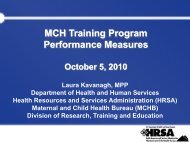(STROBE) Statement
(STROBE) Statement
(STROBE) Statement
You also want an ePaper? Increase the reach of your titles
YUMPU automatically turns print PDFs into web optimized ePapers that Google loves.
Epidemiology Volume 18, Number 6, November 2007 <strong>STROBE</strong> Initiative for Reporting Observational Studies<br />
explanatory article, 18–20 which is intended for use alongside<br />
the checklist, also benefited greatly from this consultation<br />
process.<br />
Observational studies serve a wide range of purposes,<br />
on a continuum from the discovery of new findings to the<br />
confirmation or refutation of previous findings. 18–20 Some<br />
studies are essentially exploratory and raise interesting hypotheses.<br />
Others pursue clearly defined hypotheses in available<br />
data. In yet another type of studies, the collection of new<br />
data is planned carefully on the basis of an existing hypothesis.<br />
We believe the present checklist can be useful for all<br />
these studies, since the readers always need to know what<br />
was planned (and what was not), what was done, what was<br />
found, and what the results mean. We acknowledge that<br />
<strong>STROBE</strong> is currently limited to 3 main observational study<br />
designs. We would welcome extensions that adapt the checklist<br />
to other designs—eg, case-crossover studies or ecological<br />
studies—and also to specific topic areas. Four extensions are<br />
now available for the CONSORT statement. 21–24 A first<br />
extension to <strong>STROBE</strong> is underway for gene-disease association<br />
studies: the <strong>STROBE</strong> Extension to Genetic Association<br />
studies (STREGA) Initiative. 25 We ask those who aim to<br />
develop extensions of the <strong>STROBE</strong> <strong>Statement</strong> to contact the<br />
coordinating group first to avoid duplication of effort.<br />
The <strong>STROBE</strong> <strong>Statement</strong> should not be interpreted as an<br />
attempt to prescribe the reporting of observational research in a<br />
rigid format. The checklist items should be addressed in sufficient<br />
detail and with clarity somewhere in an article, but the<br />
order and format for presenting information depends on author<br />
preferences, journal style, and the traditions of the research field.<br />
For instance, we discuss the reporting of results under a number<br />
of separate items, while recognizing that authors might<br />
address several items within a single section of text or in<br />
a table. Also, item 22, on the source of funding and the role<br />
of funders, could be addressed in an appendix or in the<br />
methods section of the article. We do not aim at standardizing<br />
reporting. Authors of randomized clinical trials were<br />
asked by an editor of a specialist medical journal to<br />
“CONSORT” their manuscripts on submission. 26 We believe<br />
that manuscripts should not be “<strong>STROBE</strong>d”, in the<br />
sense of regulating style or terminology. We encourage<br />
authors to use narrative elements, including the description<br />
of illustrative cases, to complement the essential information<br />
about their study, and to make their articles an<br />
interesting read. 27<br />
We emphasize that the <strong>STROBE</strong> <strong>Statement</strong> was not<br />
developed as a tool for assessing the quality of published<br />
observational research. Such instruments have been developed<br />
by other groups and were the subject of a recent<br />
systematic review. 28 In the Explanation and Elaboration paper,<br />
we used several examples of good reporting from studies<br />
whose results were not confirmed in further research - the<br />
important feature was the good reporting, not whether the<br />
research was of good quality. However, if <strong>STROBE</strong> is<br />
adopted by authors and journals, issues such as confounding,<br />
bias, and generalizability could become more transparent,<br />
which might help temper the over-enthusiastic reporting of<br />
new findings in the scientific community and popular media,<br />
29 and improve the methodology of studies in the long<br />
term. Better reporting may also help to have more informed<br />
decisions about when new studies are needed, and what they<br />
should address.<br />
We did not undertake a comprehensive systematic review<br />
for each of the checklist items and subitems nor did we do our<br />
own research to fill gaps in the evidence base. Further, although<br />
no one was excluded from the process, the composition of the<br />
group of contributors was influenced by existing networks and<br />
was not representative in terms of geography (it was dominated<br />
by contributors from Europe and North America) and was<br />
probably not representative in terms of research interests and<br />
disciplines. We stress that <strong>STROBE</strong> and other recommendations<br />
on the reporting of research should be seen as<br />
evolving documents that require continual assessment,<br />
refinement, and, if necessary, change. We welcome suggestions<br />
for the further dissemination of <strong>STROBE</strong>—eg, by<br />
republication of the present article in specialist journals<br />
and in journals published in other languages. Groups or<br />
individuals who intend to translate the checklist to other<br />
languages should consult the coordinating group beforehand.<br />
We will revise the checklist in the future, taking into<br />
account comments, criticism, new evidence, and experience<br />
from its use. We invite readers to submit their<br />
comments via the <strong>STROBE</strong> website (www.strobe-statement.org).<br />
ACKNOWLEDGMENTS<br />
We are grateful to Gerd Antes, Kay Dickersin, Shah<br />
Ebrahim, and Richard Lilford for supporting the <strong>STROBE</strong><br />
initiative. We are grateful to the following institutions that<br />
have hosted working meetings of the coordinating group:<br />
Institute of Social and Preventive Medicine (ISPM), University<br />
of Bern, Bern, Switzerland; Department of Social Medicine,<br />
University of Bristol, Bristol, UK; London School of<br />
Hygiene and Tropical Medicine, London, UK; Nordic Cochrane<br />
Centre, Copenhagen, Denmark; and Centre for Statistics<br />
in Medicine, Oxford, UK. We are grateful to 6 reviewers<br />
who provided helpful comments on a previous draft of this<br />
paper. The following individuals have contributed to the<br />
content and elaboration of the <strong>STROBE</strong> statement: Douglas<br />
G Altman, Maria Blettner, Paolo Boffetta, Hermann Brenner,<br />
Geneviève Chêne, Cyrus Cooper, George Davey-Smith, Erik<br />
von Elm, Matthias Egger, France Gagnon, Peter C.<br />
Gøtzsche, Philip Greenland, Sander Greenland, Claire Infante-Rivard,<br />
John Ioannidis, Astrid James, Giselle Jones,<br />
Bruno Ledergerber, Julian Little, Margaret May, David Moher,<br />
Hooman Momen, Alfredo Morabia, Hal Morgenstern,<br />
Cynthia D. Mulrow, Fred Paccaud, Stuart J. Pocock, Charles<br />
© 2007 the authors 803




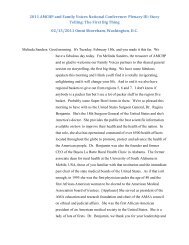



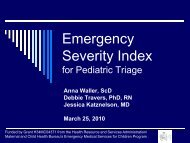
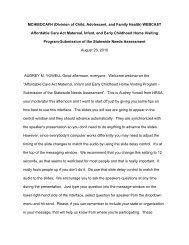
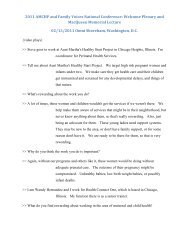
![Hormone Disruptors and Women's Health: Reasons for Concern [PDF]](https://img.yumpu.com/19410002/1/190x245/hormone-disruptors-and-womens-health-reasons-for-concern-pdf.jpg?quality=85)

